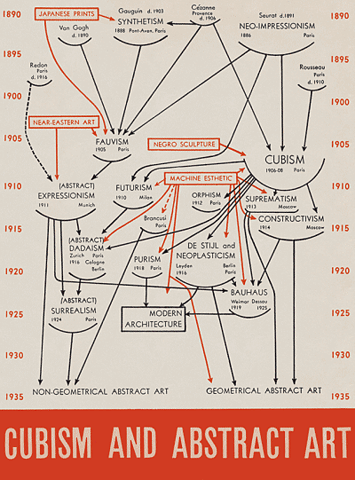05
06/09
18:05
The machine.
The machine in the XX century art. [3]
“I am accustomed, most of all at night, when the agitation of my soul fills me with cares, and I seek relief from these bitter worries and sad thoughts, to think about and construct in my mind some unheard-of machine to move and carry weights, making it possible to create great and wonderful things”
Alberti, Leon. Della Tranquilitiá dell’ animo. 1441 [qdt. 2, p.96]
I opened this post with two statements about the machine, separated for more than 500 hundred years. The painting addresses an aesthetic of the machine to the early XX century European art. The quote addresses the dreams of building machines to marvel others. Both are tied for a sort of machinic thought, however what a machine means for the Renaissance and to the XX century is as different as what machine means for us at the beginning of the XXI century.
The painting resembles an electric diagram, connections are drawn, and flows are set. From a machine aesthetic steams a variety of expressions that escape the representational path. One can venture an interpretation of this painting as the navigation tree for a web-site or an organization chart. Nevertheless, it presents a historical view of the western art in the manner as a machine is organised and deeply influenced by the machine as an abstract and aesthetic concept. This interpretation might be taken as technological determinism as long as the root and cause for this movements is found in the technical progress, but I will argue that it expresses rather a turn to the central role that technology has taken over other aspects of social relations to the point of overshadow them, in a critical way. For instance the programmatic understanding of constructivism and fragmented view of space of cubism.
Machines have a far impact in our live that we used to acknowledge, our version of the machine is quite different, these are not heavy mechanical apparatuses, rather are soft-machinic assemblages [1, p.211], and difficult to identify as machines. The cellphone that ubiquitous gadget is a machine we use to communicate with others regardless our location, that mini machine determines our capability to immediately reach somebody and our own reachability. But it is more than that it also provides with a myriad of other functions, play games, music, take pictures, videos, and read news. A machine that adapts to its owner desires, an open machine.
- Broeckmann, Andreas. “Image, Process, Performance, Machine: Aspects of an Aesthetics of The Machinic”. MediaArtHistories. Ed. Oliver Grau. Cambridge, MA: The MIT Press, 2007. 193-205
- Sawday, Jonathan. Engines of Imagination: Renaissance Culture and the rise of the Machine. London, UK: Routledge. 2007
- Wolfe, Steve. Untitled (Cubism and Abstract Art). 1997. MoMa . <https://moma.org/collection/browse_results.php?object_id=81386>
